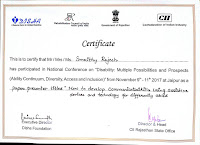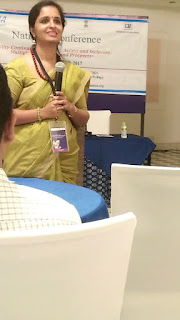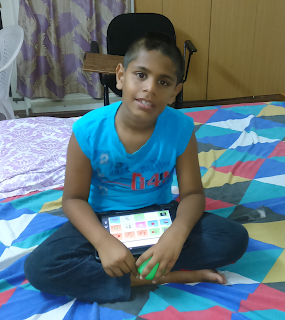Paper Presented in the National Conferance Jaipur 9- 11 Nov 2017 - "Developing Communication Skills Using Assistive Devices and Technology"
Introduction
I am
Smrithy. On completion of Post Graduation in Mathematics, I started working as
a lecturer. After marriage, I shifted to Bangalore with my husband and was
enjoying my life as a house wife. We are blessed with two children, Adhithya
who is 12 years old and studying in Class VII and Advaith, who is diagnosed
with Autism. When my son was diagnosed with Autism, I decided to do a course in
Special Education in Autism and now work as a Special Educator to assist other families
and children with Autism. I am the Special Educator, Speech Therapist,
Occupational Therapist and Sports Instructor, for my son. I created a YouTube
channel for helping other kids and families, where I upload videos depicting
how I teach reading, writing, typing, arts and sports activities like cycling,
swimming, roller-skating, badminton, scooter board and basketball. I have already
uploaded over a hundred videos on my channel and I ensure that they are done
step-by-step, for ease of understanding for the viewer.
Autism
Autism
Spectrum Disorder(ASD) and Autism are general terms for a group of complex
disorders affecting brain development. These disorders are characterised in
varying degrees by difficulties in social interaction, verbal and nonverbal communication
and repetitive behaviours. Autism appears to have its roots in the early stages
of brain development. However, the most obvious signs and symptoms of autism
tend to emerge between 2 and 3 years of age. The term “spectrum “reflects the
wide variation in challenges and strengths possessed by each person with
autism.
Importance of Early
Intervention
Early
Diagnosis and early Intervention programs are an important first step for
children with autism and those with other developmental concerns. Early
intervention services for young children span across the range of 0 to 8 years.
Early diagnosis followed by individualised early intervention can provide the best
opportunities for realising the child’s full potential.
For
example, problems with communication are a big cause of tantrums and other
difficult behaviour in children with autism. If children can’t communicate
their needs or understand others, they express themselves or get attention with
difficult behaviour. But if they learn to communicate effectively as early as
possible, they won’t need to behave like this quite so much.
Early intervention programs should be family centric, well-structured
and based on sound evidence. It should focus on developing attention, communication,
imitation, language and social skills.
Research Rationale
Difficulties
with language and communication are a key feature in the discussion on autism.
So, while training children with autism, we must work separately for speech,
language and communication. Children with autism have difficulty especially in
allocating attention and using gestures such as pointing for joint attention.
Some children on the autism spectrum remain non-verbal and some are verbal.
Verbal children can repeat words or talk about their favourite cartoons but
they struggle to use their vocabulary for communicating with others. This makes
it very important to provide an alternative method of communication for
children with autism.
Augmentative
and Alternative Communication(AAC) includes all forms of communication other
than oral speech that are used to express thoughts, needs, wants and ideas. AAC
Systems are sometimes categorised into unaided and aided systems. Unaided AAC includes
facilitated communication and sign language. Aided AAC Systems split into low
and high-tech systems. Low-tech augmentative and alternative communication
includes communication boards, picture exchange communication systems (PECS)
and picture-based AAC systems other than PECS. High tech augmentative and alternative
communication include mobile devices and voice output communication such as
speech generating devices.
Different
forms of AAC that are extensively used for children with Autism are sign
language, Picture Exchange Communication system(PECS) and Assistive Technology
devices. Through this presentation, I aim to explain how AAC and assistive
technology helped my son to learn Communication skills and how our family is
able to have a better quality of life, due to this.
Methodology
Advaith
was diagnosed with autism,SPD and ADHD at the age of 2.4 years. At that time,
he seemed severly affected with Autism and would communicate by pulling my hand
towards his desired objects. We started ABA when he was 2.5 years old. His ABA
Therapist introduced him to sign language. As I was a co-therapist for him, at
home also I started practising sign language for communication. After one month
of ABA, he started communicating for his needs like music, book, carry….
Independently. He started vocalising with first sounds while communicating.
Thereafter, we started to focus on words for communication. This put immense
pressure on Advaith and the result was regression of speech and incessant crying
during session time.
After
eight months of ABA, Advaith stopped cooperating with his therapist and was
continuously crying. Even though they tried different techniques to keep his
interest levels up, with reinforcers, it was not helping him. So, we discontinued
ABA from that Centre and I started doing ABA at home with the help of a
certified ABA therapist. Advaith was communicating with sign language at home.
He was using 12 to 15 signs at that stage.
But when I enrolled him into Bubbles Centre for Autism, I realised
that no one is able to understand his signs at school. Around that time, I
joined a course with KPAMRC (special education in autism).
In
Bubbles, they introduced picture exchange communication system(PECS).
Simultaneously I also introduced PECS at home. I created two picture cards of
his favourite food and stuck them in front of my kitchen wall. With in a week,
he started using those two cards independently for communicating. Then I
introduced other pictures like milk, juice, music etc. one by one. Then I
created a PECS file for Advaith. At that time Advaith, was using that file for
his communication with different people and at different places.
Then
I attended a workshop about ‘avaz’ which is an AAC app for kids with Autism. By
then, Advaith could use the iPad for watching his favourite rhymes and doing
some educational activities like matching and puzzles. So, under Dr. Preeja’s guidance,
I tried to start with ‘Avaz Lite’ that was a free version for seven days. I customised
Avaz with real pictures, that he could relate to easily and showed him how to
communicate using that. Advaith was very happy to hear real voices on the iPad
while using Avaz. The fact that someone was talking for him, served as
motivation. After observing his interest, we decided to buy ‘Avaz India’. After
that I customised ‘Avaz India’, the same way as he was doing using PECS. I
clicked pictures from his PECS file and added them to Avaz.
The
main transition for him was from file to technology. He was getting immediate
responses from me when he communicated with Avaz. Also, he was trying to label
different words like juice, upstairs, Kurkure while using Avaz.
In
the initial stages of training with Avaz, I was always with him to ensure that
he uses it properly. In his mind, the communication concept was clear from sign
language. At present, he uses Avaz for communicating his food requests
(ordering from restaurants also), actions like swimming, horse-riding, skating,
scooter ride and cycling, for his favourite rhymes, favourite places to go to,
talking about himself including phone number.
You can see the video of Advaith using avaz in
the following link:
Now
everyone can understand what he is trying to communicate. It works across
various languages like English, Hindi, Malayalam, Marathi, Kannada etc. His
anxiety levels reduced to a great extent because he could express his needs and
feelings to everyone. It is very easy to create folders and put pictures. They
have provided symbols for all nouns, verbs, adjectives, prepositions; we can
use our own pictures also according to the kid’s understanding level. Avaz can
be used not only for communication but also for teaching number concepts,
typing, objectives, prepositions and to build language skills and comprehension.
Journey with Avaz
|
|
Nouns
|
Food items
|
Verbs
|
Favourite actions like Swimming, Horse riding
|
Location
|
Places to go like park
|
Emotions
|
Happy, Sad
|
Rhymes
|
Favourite music
|
Personal
Information
|
Name, phone number, address
|
Greeting
skills
|
Birthday messages, Anniversary messages
|
Adjectives
|
Big, small, clean dirty
|
Prepositions
|
In, on, under
|
Story
|
Comprehension
|
Numbers
|
Counting and number value
|
Typing-alphabets
|
All alphabets
|
Typing-Words
|
Different words
|
Typing
single sentences
|
|
Typing 2
sentences
|
Findings
Avaz for autism is a full featured
research-based AAC app for autism. Avaz is designed with a focus to make speech
therapy more effective, develop the child’s language and improve his intent to
communicate. Avaz uses pictures, symbols and high-quality voice synthesis to
help users create messages and develop language skills. Avaz seamlessly
integrates a powerful keyboard to help users transitioning to text.
At
present Advaith is able to use lots of words with Avaz. When he experiences a
sensory overload, he asks for horse-riding or scooter ride. Then I realised
that those two activities help him to calm down. Through Avaz, he is able to wish
friends and family members on special occasions and this makes him feel more
connected to them.
Advaith can communicate for his needs and he
can initiate interactions .He could express his feelings and could communicate
for medicines if he has any discomfort.Avaz is his voice.He is learning
academics like prepositions,adjectives,opposites,story comprehension etc using
avaz.
Conclusion
Autism
is a lifelong disorder and affects the person’s ability to communicate, due to
which, they are not able to interact with other people or express their
feelings, leading to severe behavioural issues. During early intervention, if
we introduce proper communication techniques to the children, it helps them
throughout life. Even though PECS is a good communication system for children
with autism, it is very difficult to manage with only PECS across all
situations. Now technology is growing at a fast pace and we can achieve
functional expertise in every area through technology. Therefore, it is very
important to train these kids on using technology.
Avaz
is a very useful app for children with Autism. Avaz can be used for non-verbal
and verbal kids to improve their communication skills, build more comprehension
skills and to teach Academics. They can carry their Communication device
always.
Recommendations
1. Understand ASD. Accept ASD. It is
a life-long challenging disorder, but there are ways to minimize the effects
and improve the quality of life of not just your child but also yours.
2.
The focus should be towards communication first and then
speech. We, as parents would want to
know what our child wants or is feeling than name alphabets, rhymes or
numbers. This would help reduce
behavioral challenges and improve our bonding with our child. The focus should
be on comprehension and expression of concepts rather than only comprehension.
3.
Mother is the best therapist and
love is the best method for children with special needs. It is very important
to take guidance from experienced professionals and parents should follow the
same techniques at home. We must remember that communication happens everywhere
and not only in a classroom setting. A child goes to therapy centres or school
for a maximum of 3 to 5 hours per day and the remaining 7 to 9 hours are spent
with parents and caretakers. So, parents and caretakers play a very important
role in the development of the child’s communication skills.
4.
Professionals are trained
experts. Take their suggestions, observe how intervention is planned and worked
upon. We as parents know our child
better. So encouraging similar strategies at home in the manner that we think
will work in a particular scenario. Enrolling for therapies cannot succeed
without parent professional partnership.
Empower yourself by learning how to carry out therapeutic activities at home
and co-partner intervention.
The
journey with Advaith has only started and we have a long way to go. We already
know the road to our destination.
Smrithy
Rajesh
Acknowledgements:
Ms.
Sarbani Mallick, Founder Director/ Managing
Trustee, Bubbles centre for autism. Email: sarbani@bubblesblr.org
Dr
Preeja Balan, Director-Speech language Pathologist, Octave Hearing and Speech
Centre. Email: info@octavecentre.com
Disclaimer: There are no financial
interests or monetary compensation from Avaz manufacturers for this
presentation. My intent is in portraying the journey travelled by us with
Advaith using the Avaz app






Comments
Post a Comment